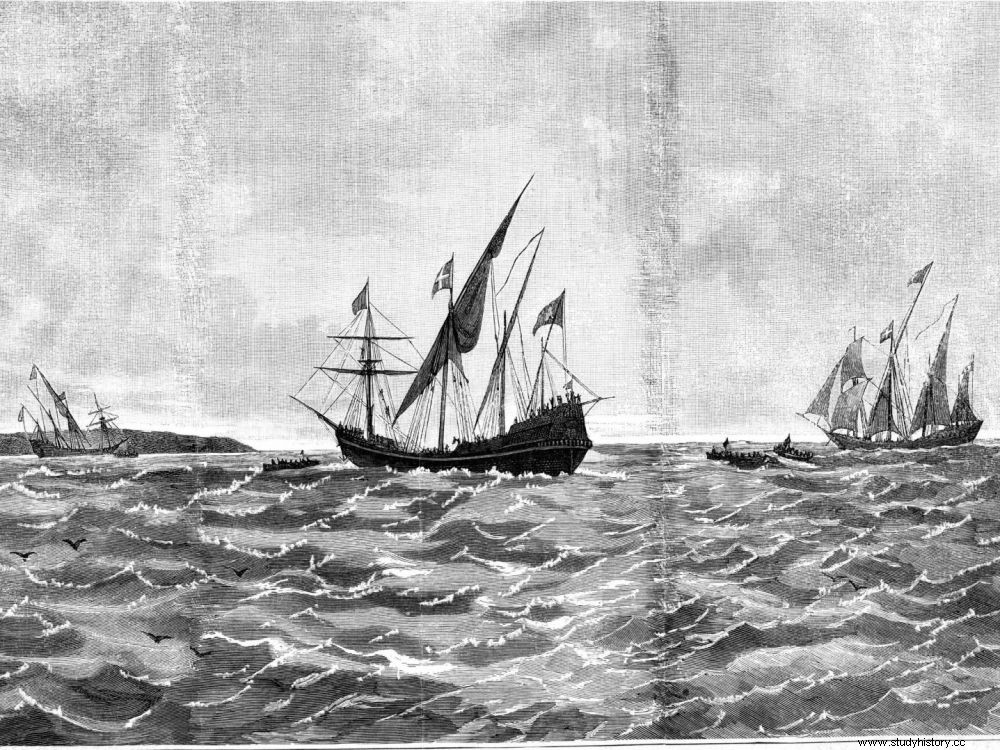Christopher Columbus was accused of bringing the bacterium Treponema pallidum to Europe. from the New World, causing an outbreak of syphilis cases. A new study casts doubt on this scenario.

Christopher Columbus and his caravels arrive on the island of Guanahani, later renamed San Salvador.
Was Christopher Columbus responsible for the spread of syphilis in Europe? A study conducted by an international team of researchers and published on August 13, 2020 in the journal Current Biology could exculpate the Genoese navigator.
Infections before Christopher Columbus reached America
Syphilis is one of the best known sexually transmitted diseases. According to Public Health France, 1762 diagnoses of syphilis were declared in 2018 in France. Still today, this infection caused by a subspecies of the bacterium Treponema pallidum (Treponema pallidum pallidum ) is a real health issue with more than 10 million infections worldwide in recent decades. If from now on the injection of penicillin helps to fight the disease, in Europe, between the 15th and the 18th century, this one, not contained, made devastations. Its origin is not clearly established but the most widespread hypothesis is that Christopher Columbus and his sailors are responsible for its diffusion in Europe after their visit to the New World. Finally, the navigator and his team may not be responsible for the epidemic, judging by the results obtained recently by the researchers.
They discovered traces of infections with bacteria of the genus Treponema on human remains unearthed in the Netherlands, Estonia and Finland. The pathogens had an age between the beginning of the 15th century and the 18th century. The dating of the sample from Estonia is particularly interesting. It indicates infection with Treponema pallidum pallidum between the beginning and the middle of the 15th century, i.e. "distinctly before the expeditions of Columbus " which began at the end of the century. "This dating would place the first contagions of Treponema pallidum pallidum in Europe prior to New World contact, suggesting that the original causative agent of the continental epidemic in the late 15th century may have resided in the Old World ", note the authors. The disease was therefore already present in Europe. It is not excluded, however, that recombinations took place between the strains imported from America and those endemic, precipitating the epidemic then in Europe. But "it seems that the first known outbreak of syphilis cannot be attributed solely to Columbus's voyages to America ", concludes Verena Schünemann, co-author of the study.
A new disease discovered
Treponematoses are diseases caused by different subspecies of the bacterium Treponema pallidum. T. pallidum pertenue is the agent of a disease called yaws and T. pallidum endemicum is the agent of bejel. Researchers discovered that one of the individuals was infected with yaws, a disease now only detected in tropical and sub-tropical regions. "Our data indicates that yaws spread throughout Europe. It was not limited to the tropics, as it is today “, emphasizes in a press release Verena Schünemann.
Finally, last discovery and not least:the skeleton found in the Netherlands was infected by a strain unknown until now. This pathogen was responsible for a disease that evolved in parallel with syphilis and yaws, but which no longer exists today. "This unexpected discovery is particularly exciting for us, as this lineage is genetically similar to all current subspecies, but also possesses unique qualities ", enthuses Kerttu Majander, lead author of the study. Eventually, different subspecies of closely related bacteria cohabited throughout Europe for several centuries.
